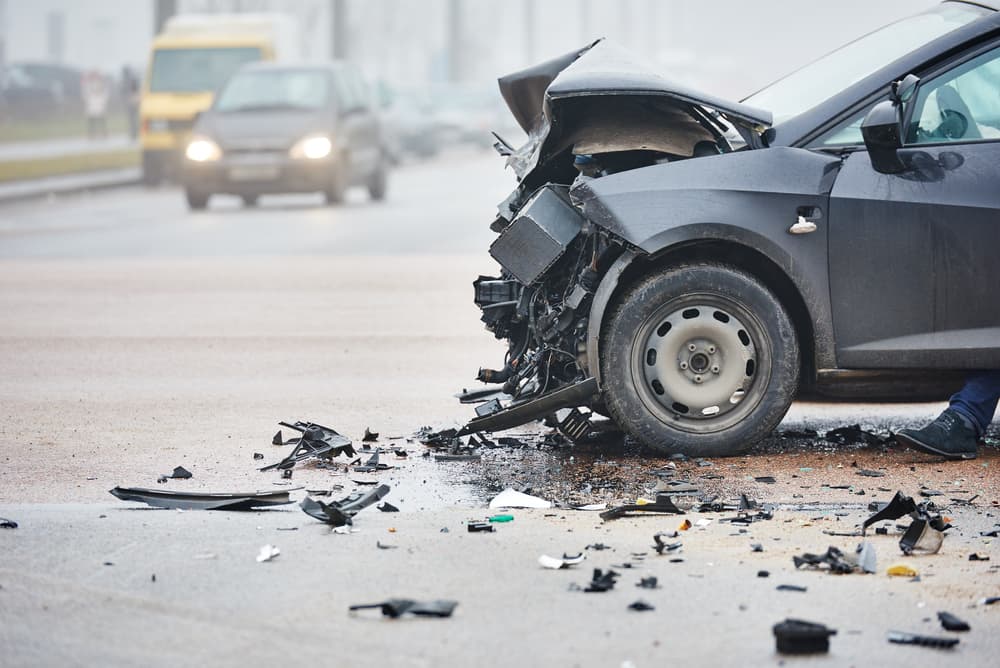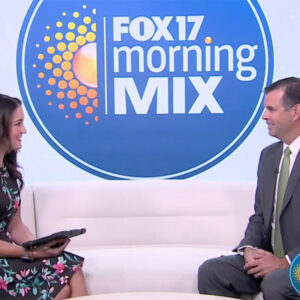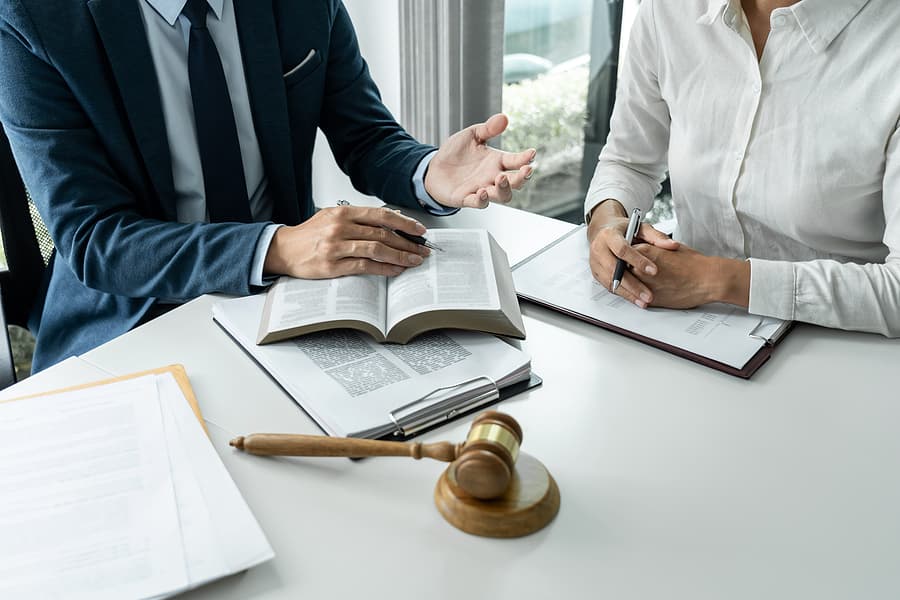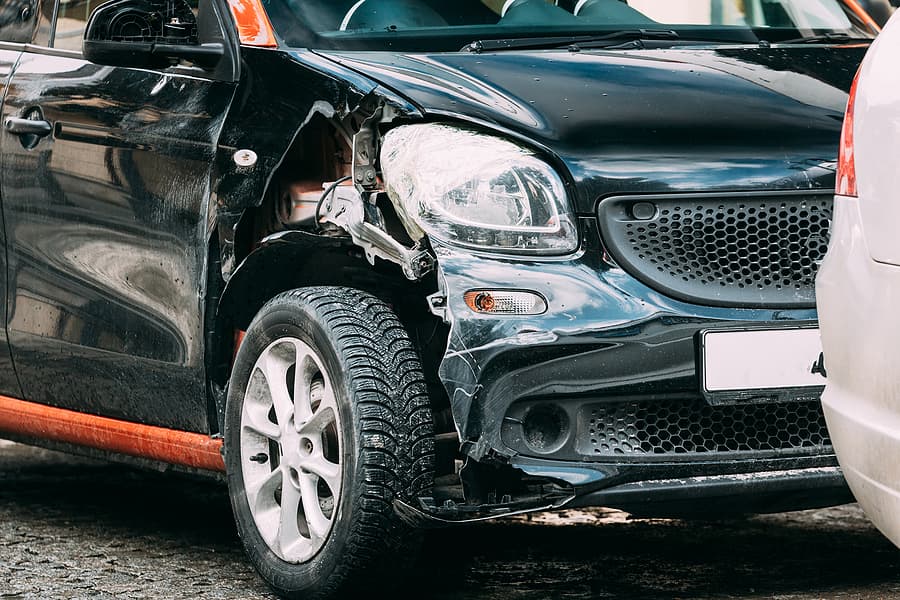Car accidents happen in a variety of ways. The type of car accident that occurs can often provide crucial information about how an accident happened, who is at fault, and the injuries that commonly result from that type of crash. The most common types of accidents can be categorized as follows:
Head-on crash
Head-on collisions occur when vehicles traveling in opposite directions collide directly. These collisions are often catastrophic and are more likely to cause serious injuries and death than other types of collisions because of the competing forces at play. These crashes typically occur when one car is on the wrong side of the road, such as with drunk or distracted driving, unsafe passing, drowsy driving, swerving to avoid an animal or construction zone, or loss of control due to ice or water on the road. Head-on crashes are more common in rural areas along two-lane roads with no dividers.
Speed is often a contributing factor in more serious head-on collisions. However, a serious head-on crash can happen at any speed, particularly when a larger or heavier vehicle is involved with a standard passenger vehicle.
T-bone collision
In a T-bone or “broadside” crash, the front end of one vehicle collides with the side of another. These accidents are most common at intersections, such as when one driver runs a red light or makes a left-hand turn into oncoming traffic. These crashes are particularly dangerous for the people on the side of the car that is struck because the only barrier between them and the oncoming vehicle is the thin door.
The cause of a T-bone crash is generally that one driver failed to yield the right-of-way to the person who had the right to pass through the intersection first. Because there are clear rules for who has the right-of-way at intersections, it is often easy to determine who was at fault in T-bone crashes once the facts are established. To avoid these types of crashes, always make sure that other traffic has stopped before entering an intersection and never count on other drivers to slow or stop for you.
Rear-end crash
A rear-end collision, also called a fender bender, occurs when the front of one vehicle strikes the back of another. These types of accidents typically happen in congested areas when heavy traffic requires vehicles to stop and go over a stretch of road. Additionally, rear-end crashes are common when one vehicle slows or stops and the vehicle behind them does not notice, often due to drunk, distracted, or drowsy driving. These crashes are much more likely when a driver is tailgating.
Many people may try to downplay rear-end crashes and label them as minor collisions. However, that is not always the case. When the vehicle that causes the rear-end crash is traveling at a high rate of speed or is much larger than the vehicle struck, significant damage and injuries can occur. The human body is also fragile, and even low-speed collisions can cause significant injuries.
The sudden and unexpected thrust forward of an occupant’s body in this type of collision can cause injuries such as whiplash, fractures or disc bulges in the neck and back, traumatic brain injuries, broken bones, including broken ribs or clavicles from the seat belt, or injuries to the knees and ankles when the lower extremities are pushed into the dashboard.
Multi-car accidents or pileups
A chain reaction accident is one in which the force of the initial collision causes the vehicle that was struck to hit another vehicle or other vehicles become involved in the crash because there is no way to avoid the disabled vehicles.
These multi-car pile ups can happen anywhere but are most common on highways and interstates during heavy traffic or bad weather. These are often mass casualty events that can result in injuries or fatalities to multiple victims. In Michigan, these crashes often occur when the roads are icy and snow causes white-out conditions; an initial collision occurs and drivers behind them cannot see that they have to stop.
Liability in these types of car crashes is very complex, and multiple insurers will be involved. It can be difficult to determine who is liable for a victim’s injuries.
Single car crash
A crash in which only one car suffers damage can happen for many reasons. A single car crash happens when a driver loses control of their vehicle and leaves the roadway or hits a tree, pole, or other obstacle. This can be the result of drunk, distracted, or drowsy driving, poor road conditions or weather, swerving suddenly to avoid an animal or debris in the road, and more. Passengers who are seriously injured in this type of collision may be able to seek damages from the driver.
Single car crashes can also involve another vehicle that does not physically impact the other. One driver may lose control while attempting to avoid a collision with someone who was driving negligently or suddenly darted out into traffic. Thus, there may be another party at fault even in a single-car crash.
Single car crashes are actually the most common type of crash in Michigan by a significant margin.
Sideswipe impact
Sideswipes occur when vehicles collide while they are traveling in the same direction. For example, a vehicle that encroaches or drifts into another vehicle’s lane may hit the side of another car, or a car that changes lanes may strike a vehicle in its blind spot.
While these accidents tend to be less severe than others, they can still be deadly. A sideswipe in moving traffic can cause a vehicle to careen off the road, roll over, or strike other vehicles near them when the impact is forceful.
Rollover crash
These accidents can be some of the most terrifying to experience and often result in severe injuries or death to occupants in the rollover vehicle. Rollovers are the second most dangerous type of crash, after head-on collisions. If the occupants of the vehicle are not wearing their seatbelts, the outcome is often far worse.
Any number of actions can trigger the rollover of a vehicle. Speed, quick turns, erratic maneuvers, fast lane changes, and other reckless driving can cause a car to flip. Other causes include uneven pavement or poor road condition, problems with how cargo is loaded, being struck on the side by another vehicle, or swerving to avoid a reckless driver.
Although any type of car can roll over, SUVs, large trucks, and vehicles elevated off the ground are more likely than lower profile vehicles to roll because their center of gravity is higher.
What Causes Most Car Accidents?
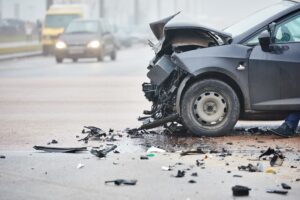 The cause of most car accidents is simply driver error. Negligence – not driving with reasonable care and caution – is responsible for most motor vehicle accidents and, in turn, the injuries and losses suffered by innocent victims.
The cause of most car accidents is simply driver error. Negligence – not driving with reasonable care and caution – is responsible for most motor vehicle accidents and, in turn, the injuries and losses suffered by innocent victims.
We have all seen drivers engaging in dangerous and potentially negligent behaviors behind the wheel. When a driver endangers the safety and lives of others through negligent driving, they are responsible for the injuries and damages that result from their actions. The following are examples of negligence that commonly result in motor vehicle accidents.
Examples of Negligent Causes of Car Accidents
Drunk driving
Drivers under the influence of drugs, alcohol, or prescription medications are a danger on the roadways. In an instant, an intoxicated driver can cause an accident with another vehicle traveling near them. Drivers with drugs or alcohol in their system who get behind the wheel have slower reaction times, poor decision-making ability, and struggle to stay alert while driving. Driving under the influence of drugs or alcohol is clear negligence and is often also criminal behavior.
Driving while distracted
In today’s busy world, drivers face a multitude of potential distractions and it can be tempting to try to multitask while driving. Phone calls, text messaging, navigation systems, entertainment, eating, grooming, and even other occupants within the vehicle are potential causes of distraction while on the road. It only takes one lapse for a driver to take their attention from the road ahead for a few seconds and end up causing a serious accident. More than 1,000 crashes per day happen in the United States because of distracted driving.
Fatigued driving
Intoxicated driving is an obvious danger to society, but many people do not realize that fatigued driving can be just as dangerous. After 20 hours without sleep, drivers exhibit the same impairments to reaction time, vigilance, and coordination that drivers with a 0.08 blood alcohol level do.
Those who work on the road, such as commercial truck drivers, are at higher risk of suffering the effects of driver fatigue and causing accidents involving passenger vehicles. Sadly, when an accident occurs between commercial trucks and cars, it is often severe and life-threatening injuries are likely.
Failure to follow traffic laws
The consequences of breaking traffic laws go far beyond just getting a ticket from an officer. When drivers do not respect the rules of the road and fail to stop at traffic signals, abide by speed limits, or follow road signs, crashes are likely to result. Police who arrive at the crash scene generally identify the hazardous action that led to a crash and either issue a ticket or seek criminal charges against the driver who caused the crash. While a citation alone will not prove liability in an accident, it can be persuasive to the insurer when it is determining who was at fault and who is liable for the damages caused in the crash.
Reckless driving
Driving recklessly can encompass a wide range of actions on the road. Motorists that drive aggressively, change lanes without regard, speed, or make dangerous maneuvers can cause accidents with those around them. Reckless driving may not always violate traffic laws, depending on the driver’s actions. Yet, it can be evidence of negligence when the driver is not driving like an ordinary, prudent person would under the circumstances.
What Are Your Rights After a Motor Vehicle Crash Causing Damage and Injury?
If you have been in a car accident, you may be wondering how you can pursue compensation for your injuries. Generally, there will be a no-fault insurance policy that must pay for some or all of your medical bills, three years of wage loss, and services you need around the house. You are entitled to these benefits regardless of who was at fault in the crash.
If you or a loved one suffers serious injuries, disfigurement, or death in a car accident due to the negligent actions of another driver, the law allows you to recover other damages from the at-fault party. Drivers are required to have liability insurance in Michigan, so the at-fault party’s insurance company will be involved.
If the at-fault driver does not have insurance or enough insurance to cover your remaining damages, you may be able to return to your own insurer and collect benefits under an uninsured or underinsured motorist policy. This is optional coverage that you may or may not have chosen to include in your policy.
Damages Available to Car Accident Victims
A person injured in a motor vehicle collision can seek specific categories of damages, whether through an insurance claim or from the at-fault driver.
Damages in a car accident insurance claim include:
- Medical expenses for the treatment of your injuries, including ambulance trips, ER visits, hospital care, physical therapy, doctor visits, surgeries, in-home care, and more.
- Necessary modifications to your home or car to facilitate mobility, such as a wheelchair ramp, accessible bathtub, or vehicle lift
- Income loss for the first three years, including your lost wages due to the accident and while you heal from your injuries.
- A per-day stipend for replacement services, which are household tasks that you cannot complete while you are recovering such as mowing, shoveling, cooking, or cleaning.
Damages in a claim against the at-fault driver include:
- Any of the above expenses that are not covered by your no-fault insurer.
- Pain and suffering, including physical distress and emotional suffering.
- Personal losses from your reduced quality of life.
- Property damage for repairs or loss of your vehicle and any other property damaged in the crash.
Should You Call a Car Accident Attorney?
You should always consult with a car accident attorney when you are in an accident. Gruel Mills offers free consultations, which allows you to discuss your case risk-free and decide what the best options are for you moving forward. Hiring an attorney is the best thing you can do to protect your rights after a car crash.
An attorney representing your interests from the get-go gives you an advantage when dealing with an insurer. Furthermore, it prevents unnecessary, avoidable complications due to common errors or omissions when filing a claim and providing information to the insurance company.
If you or a loved one are injured in a car accident, call us today to schedule a free consultation.
